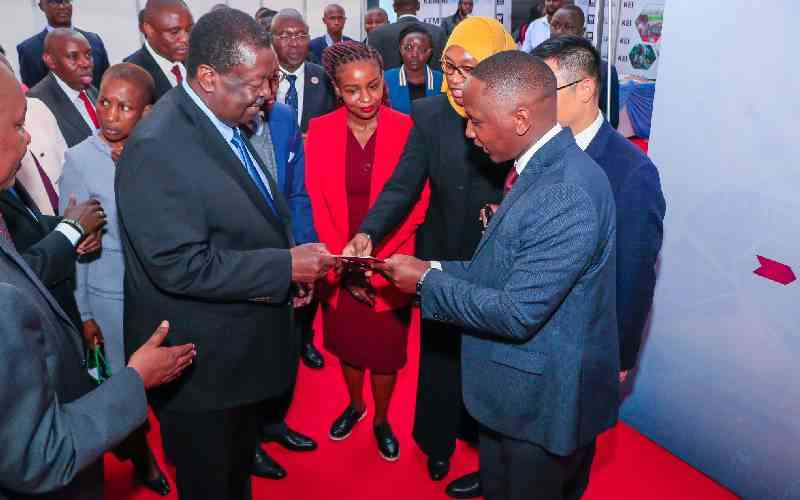By Timothy Makokha
Kenya is inching closer to the new dawn of virtual learning thanks to the fast revolution in the Information and Communication Technology (ICT) industry.
UUNET Kenya, a business communication solutions provider in partnership with Strathmore Business School (SBS) joined forces to spearhead the first virtual classroom in Kenya.
While originally created for distance education, virtual learning is often used to supplement traditional face-to-face classroom activities, commonly known as Blended Learning. As a result, several students are taught at the least cost possible.
A virtual classroom encompasses a collaborative video conferencing solution that enables one to communicate synchronously using video and audio or through text chat.
It also allows the sharing of presentations, documents and images on an interactive whiteboard with students in remote areas. The high-end solution in use at SBS has the potential to improve education standards.
A virtual classroom enables over 100,000 students in different locations to be in the same class at the same time by connecting to the classroom via their computers from different locations.
The students can listen and learn via voice, watch the professor write on the electronic white board, pose questions via chat/email and view related materials during sessions.
The revolutionary educational video conferencing solution supports homework submission, immediate web-based testing and examination of students and quick links to chat rooms for after-class student discussions on every aspect of the day’s lessons.
An institution adopting this system could also eliminate 70 per cent of costs as the need for many facilities is eliminated.
The video conferencing solutions by UUNET Kenya are opening room for Virtual education in Kenya.
Strathmore Business School is now able to give instructions in a learning environment where lecturers and students are separated by time and/or space. Lecturers have started providing course content through management applications and multimedia resources.
SBS, the first institution to acquire the video conferencing solutions three months ago are now able to show documents, photos in learning sessions.
The solution has also enabled the institution to share printed documents, give power point presentations and record entire meetings and lectures on video.
Global exposure
Stay informed. Subscribe to our newsletter
Through the technology, Strathmore has a chance to expose its students to international faculties and research methodologies, cutting travel costs while improving the quality of education.
Kenya College of Accountancy (KCA) University is also set to acquire the video conferencing solution soon.
The latest development draws from the World Bank-funded African Virtual Universities (AVU) initiative, which was conceived in 1995 to help higher institutions in sub-Saharan Africa to develop capacity in technical and science disciplines.
Then, a survey had revealed that higher education on the continent suffered various challenges related to access, finances, quality, internal and external efficiency, limited space and declining budgets.
According to Dr Bakary Diallo, AVU Rector in a previous interview, these problems called for the introduction of alternative modes of delivery of tertiary education to compliment the efforts of existing higher-learning institutions.
In 1997, the World Bank launched the AVU to mitigate the situation. Initially, says Diallo, AVU’s focus was on delivering brokered content in science and technology to African students and lecturers through the establishment of learning centres. This was intended to bridge the digital gap between the developed and developing world.
Today, the approach is different, partly necessitated by the need to cut high operational costs and to circumvent the unending challenges of power outages, digital illiteracy, poor connectivity in some areas and lack of computers and telephone access.
As a result, AVU took a paradigm shift, developing an open distance and eLearning (ODeL) model that emphasises the use of mixed modes of delivery, from low to high-level technological contexts.
Through collaboration with AVU, universities have exposed their students and lecturers to rigorous scholarship and groundbreaking research.
But more scintillating has been the extent to which the initiative has gone to ease the strain that previously limited the provision of education in several African countries.
Supported by the UNDP, AVU undertakes various initiatives in Somalia, including enhancing the Somali human capital, promoting peace building, providing scholarships for Somali women and setting up a community radio.
In Somali, a region that ordinarily would not host conventional learning models due to war, the AVU open distance and eLearning courses have remained a pillar in the institutional development programmes since 2004.
These programmes boast over 4,000 graduates, 30 per cent of whom are female — a feat in its own right because women in Somali have suffered marginalisation at the hands of Islamic extremists.
The AVU professional courses, like English training, journalism and information technology (IT), maximise existing systems and address acute training needs for Somali human capital to increase economies of scale.
Diallo says the University of Hargeisa in Somalia, the host of the first AVU learning centre, has inspired six other Somali universities to follow suit: Amoud University, East Africa University, Puntland State University, Mogadishu University, Somali Institute of Management and Administration Development and the University of Burao.
Three of these institutions, the University of Hargeisa, East Africa University and Amoud University, are also participating in the continent-wide AVU Teacher Education programme — an initiative that trains teachers.
AVU is also working with other partners to enhance the open distance and eLearning capacities of higher-education institutions throughout Africa.
Elsevier and the African Association of Universities are collaborating on a project to offer ScienceDirect (an information resource for scientific, technical, and medical research) and Scopus — (the largest abstract and citation database of research literature and web sources) on a deeply discounted basis to universities in Central, East and West Africa.
In what has been described as "Expensive science for poorest nations" this project allows students, lecturers, and researchers in under-resourced nations to access essential scholarly and scientific information from peer-reviewed journals.
Elsevier’s alliance with AVU provides mathematicians and physicists in sub-Saharan Africa with access to ScienceDirect, an online collection of more than 2,000 peer-reviewed journals.
In Kenya, students and researchers of Methodist University, through AVU and ScienceDirect, access digital libraries with online academic literature and links to other international libraries.
 The Standard Group Plc is a
multi-media organization with investments in media platforms spanning newspaper
print operations, television, radio broadcasting, digital and online services. The
Standard Group is recognized as a leading multi-media house in Kenya with a key
influence in matters of national and international interest.
The Standard Group Plc is a
multi-media organization with investments in media platforms spanning newspaper
print operations, television, radio broadcasting, digital and online services. The
Standard Group is recognized as a leading multi-media house in Kenya with a key
influence in matters of national and international interest.
 The Standard Group Plc is a
multi-media organization with investments in media platforms spanning newspaper
print operations, television, radio broadcasting, digital and online services. The
Standard Group is recognized as a leading multi-media house in Kenya with a key
influence in matters of national and international interest.
The Standard Group Plc is a
multi-media organization with investments in media platforms spanning newspaper
print operations, television, radio broadcasting, digital and online services. The
Standard Group is recognized as a leading multi-media house in Kenya with a key
influence in matters of national and international interest.





